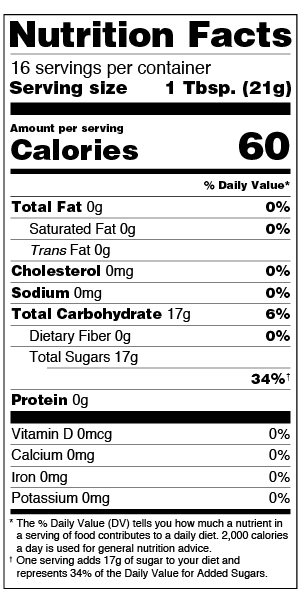Food labels catch people’s attention for several reasons. However, a lot of customers would like to know how to use this information more readily and successfully, for whatever reason. The purpose of the following label-reading techniques is to help you use Nutrition Facts labels to quickly and easily make well-informed food choices that support a balanced diet.
Each food and beverage product has different information in the main or top part (see #1–4) of the sample nutrition label (below); this information consists of product-specific details (nutrient information, serving size, and calories). A footnote explaining the percentage Daily Value and providing the quantity of calories used for general nutrition guidance may be found at the bottom of the section.
To make it easier for you to concentrate on the parts that will be covered in more detail, we have colored-coded several sections of the Nutrition Facts label below. Keep in mind that the food labels of the items you buy do not actually have these colored sections on them.

1. Serving Information
(#1 on sample label)

Prior to reading the Nutrition Facts label, note the serving size and the number of servings per container in the packaging. To facilitate the comparison of similar items, serving sizes are standardized and given in units that are easily understood, like cups or pieces, followed by the metric amount, like grams (g). The amount that individuals usually eat or drink is reflected in the serving size. It doesn’t suggest how much food or liquids you should consume.
It’s critical to understand that all of the nutritional quantities, including the calorie count, are expressed in relation to the size of the serving. Take note of the serving size and, in particular, the quantity of servings included in the food box. Consider asking yourself if you are eating one serve, a half-serving, or more. A serving of lasagna is equivalent to one cup according to the sample label. You would be consuming two servings if you ate two cups. That is twice the number of calories and nutrients listed on the sample label; therefore, to find out how much you are getting in two servings, you would need to double the amounts of calories and nutrients as well as the percentageDVs.
| Example | ||||
|---|---|---|---|---|
| One Serving of Lasagna | %DV | Two Serving of Lasagna | %DV | |
| Serving Size | 1 cup | 2 cups | ||
| Calories | 280 | 560 | ||
| Total Fat | 9g | 12% | 18g | 24% |
| Saturated Fat | 4.5g | 23% | 9g | 46% |
| Trans Fat | 0g | 0g | ||
| Cholesterol | 35mg | 12% | 70mg | 24% |
| Sodium | 850mg | 37% | 1700mg | 74% |
| Total Carbohydrate | 34g | 12% | 68g | 24% |
| Dietary Fiber | 4g | 14% | 8g | 29% |
| Total Sugars | 6g | 12g | ||
| Added Sugars | 0g | 0% | 0g | 0% |
| Protein | 15g | 30g | ||
| Vitamin D | 0mcg | 0% | 0mcg | 0% |
| Calcium | 320mg | 25% | 640mg | 50% |
| Iron | 1.6mg | 8% | 3.2mg | 20% |
| Potassium | 510mg | 10% | 1020mg | 20% |
2. Calories
(#2 on sample label)
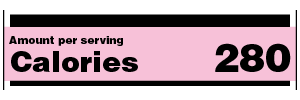
An indicator of how much energy a portion of this dish contains is its calorie count. In the given example, a serving of lasagna contains 280 calories. Imagine consuming the entire package. You would then eat 1,120 calories, or 4 portions.
Achieving and maintaining a healthy body weight requires striking a balance between the amount of calories your body uses and the amount of food and drink you consume. Nutritionists often recommend 2,000 calories per day as a starting point. Your age, sex, height, weight, and degree of physical activity can all affect how many calories you need.
3. Nutrients
(#3 on sample label)
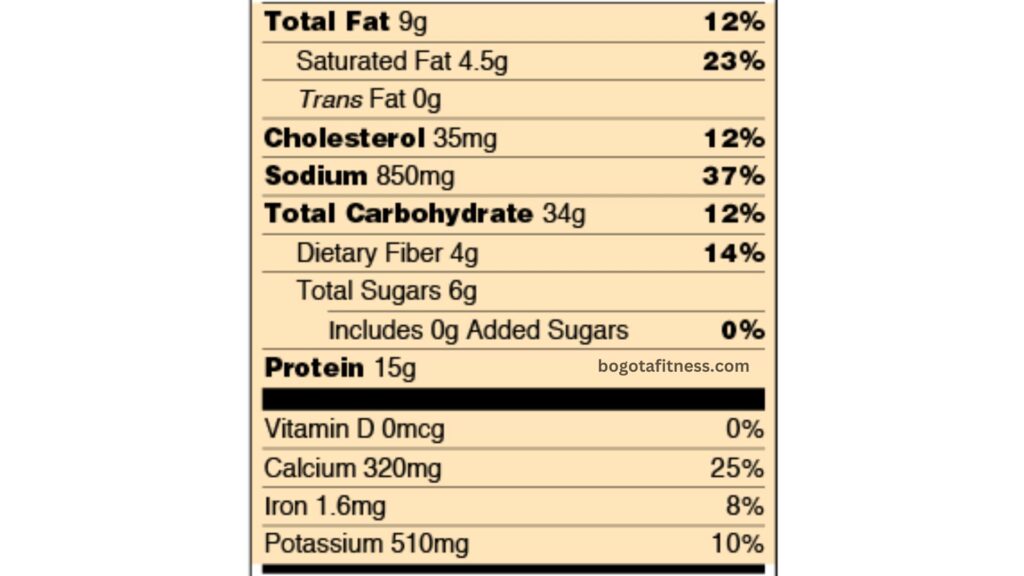
Examine section 3 of the provided label. It reveals certain important nutrients that have an effect on your well-being. Look for foods that include more of the nutrients you want to obtain more of and less of the nutrients you might want to limit. You can utilize the label to support your individual dietary goals.
Nutrients to get less of: Saturated Fat, Sodium, and Added Sugars.
The ingredients stated on the label that may be linked to negative health impacts are saturated fat, salt, and added sugars, all of which Americans typically consume in excess. There is a list of nutrients that one should consume less of. Consuming excessive amounts of sodium and saturated fat, for instance, raises the chance of acquiring certain diseases, such as high blood pressure and cardiovascular disease. It might be challenging to achieve critical nutrient needs while remaining under calorie limitations if added sugar consumption is excessive.
What are Added Sugars and How are they Different from Total Sugars?
Total Sugars, as listed on the Nutrition Facts label, comprises both any added sugars that may be included in the product and the sugars that are naturally found in a variety of healthful foods and drinks, such as fruit and milk. Since there is no suggested daily allowance for the entire amount of sugars, no Daily Reference Value for total sugars has been developed.
The Nutrition Facts label lists added sugars as follows: foods packaged as sweeteners (table sugar, for example), foods added during food processing (sucrose or dextrose), sugars from syrups and honey, and sugars from concentrated fruit or vegetable juices. It can be challenging to consume the daily necessary amounts of key nutrients while keeping within calorie limitations while following a diet heavy in calories from added sugars.
Note: If the term “includes” appears on the label before the word “Added Sugars,” it means that the amount of grams of Total Sugars in the product includes the Added Sugars as well.
A yogurt carton with additional sweets, for instance, might say:

This indicates that there are a total of 15 grams of sugar in the product—7 grams of added sugar and 8 grams of naturally occurring sugar.
Nutrients to get more of: Dietary Fiber, Vitamin D, Calcium, Iron, and Potassium.
The label lists elements such as dietary fiber, vitamin D, calcium, iron, and potassium that most Americans do not obtain in the required amounts. There is a designation for these nutrients: more of them. Consuming a diet rich in dietary fiber can decrease blood glucose and cholesterol levels, increase the frequency of bowel movements, and save calories. Increased intake of vitamin D, calcium, iron, and potassium in the diet can lower the risk of anemia, osteoporosis, and hypertension.
Recall that you may use the label to support your individual dietary requirements by selecting items that have lower amounts of some nutrients you may wish to limit and higher amounts of the nutrients you want to get more of.
Also Read: INTERMITTENT FASTING: BENEFITS, METHODS, AND TIPS FOR SUCCESS
4. The Percent Daily Value (%DV)
(#4 on sample label)
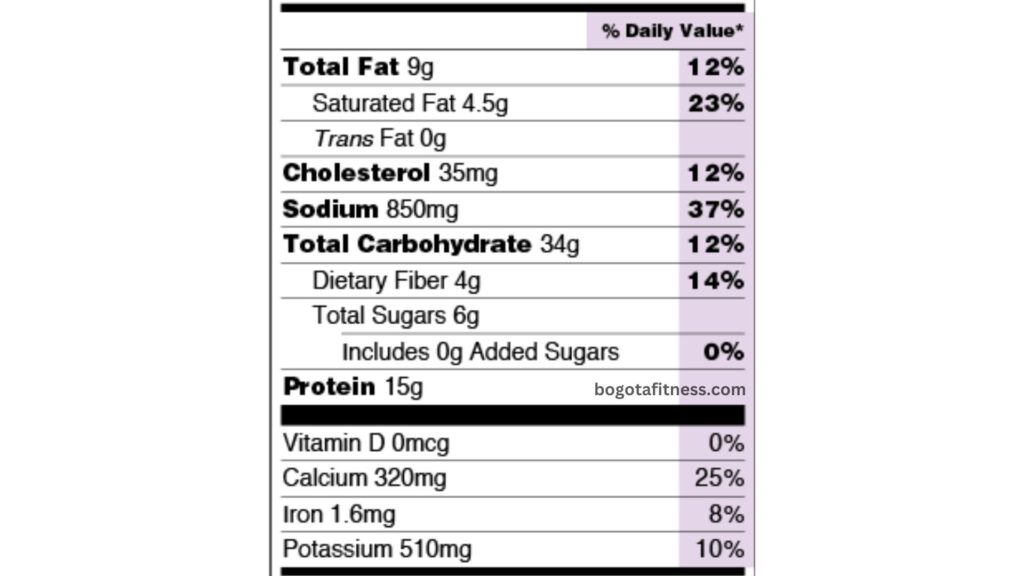
The percentage of the Daily Value for each nutrient in a serving of food is indicated as the % Daily Value (%DV). The Daily Values are recommended daily intake levels of specific nutrients, measured in grams, milligrams, or micrograms.
The percentageDV indicates the contribution of a nutrient in a serving of a food to the daily allowance.
You can tell if a serving of food has a high or low amount of a nutrient by looking at the%DV.
Does using the %DV require you to know how to compute percentages? No, because the calculation is done for you by the label (the %DV)! By placing all of the nutrient values on a single daily scale (0–100%DV), it makes it easier for you to understand the quantities in grams, milligrams, or micrograms. The vertical sum of the %DV column is not 100%. Rather, the percentage of the Daily Value (%DV) for every nutrient in a serving of food is indicated. It can inform you of a food’s high- or low-nutrient content as well as how much or how little a serving of the item adds to your daily intake of each nutrient.
Note: Some nutrients, such as total carbohydrates and trans fat, do not have a percentageDV on the Nutrition Facts label; they will be covered in more detail later.
General Guide to %DV
- 5% DV or less of a nutrient per serving is considered low
- 20% DV or more of a nutrient per serving is considered high
Frequently, select foods that are:
- Higher in %DV for Dietary Fiber, Vitamin D, Calcium, Iron, and Potassium
- Lower in %DV for Saturated Fat, Sodium, and Added Sugars
Example: Check out the sample nutrition label’s listing of the salt content in one serving. How much or how little does the%DV of 37% contribute to your diet? Consult the %DV General Guide. With 37% DV for sodium, this product is classified as HIGH sodium (having more than 20% DV for sodium). Two servings would offer you 74% of the daily value (DV) for salt, or about three-quarters of the daily recommended intake.

Compare Foods:When comparing food products, use the percentage of daily value (%DV) and, if possible, choose those with higher nutrient content that you want to consume more of and lower nutrient content that you want to consume less of. Just be sure to keep in mind the serving size.
Understand Nutrient Content Claims: To help differentiate between claims that are “light,” “low,” and “reduced,” use %DV. To determine whether food product has more or less of a specific nutrient, just compare the percentageDVs in each one. Definitions don’t need to be committed to memory.
Dietary Trade-Offs:To assist you in trading off certain foods throughout the day, you can use the %DV. Maintaining a healthy diet doesn’t require you to give up your favorite dish. If you enjoy a food that is rich in saturated fat, try to balance it out with other foods that are low in saturated fat during the day. Additionally, monitor your daily intake to ensure that the overall quantity of saturated fat and other nutrients you wish to restrict is kept below 100%DV.
To assist you in trading off certain foods throughout the day, you can use the %DV. Maintaining a healthy diet doesn’t require you to give up your favorite dish. If you enjoy a food that is rich in saturated fat, try to balance it out with other foods that are low in saturated fat during the day. Additionally, monitor your daily intake to ensure that the overall quantity of saturated fat and other nutrients you wish to restrict is kept below 100%DV.
| Nutrient | DV | %DV | Goal |
|---|---|---|---|
| Saturated Fat | 20g | =100% DV | Less than |
| Sodium | 2,300mg | =100% DV | Less than |
| Dietary Fiber | 28g | =100% DV | At least |
| Added Sugars | 50g | =100% DV | Less than |
| Vitamin D | 20mcg | =100% DV | At least |
| Calcium | 1,300mg | =100% DV | At least |
| Iron | 18mg | =100% DV | At least |
| Potassium | 4,700mg | =100% DV | At least |
Maximum – Consume “Less than”…
Upper limit refers to the recommendation to consume “less than” or remain below the Daily Value nutrient quantities mentioned each day. For instance, 20g is the DV for saturated fat. For this vitamin, this amount is 100% DV. Is there a diet plan or an objective? should consume 100%DV or “less than” 20 g daily.
Lower Limit: Consume “At least”
Dietary fiber has a DV of 28g, or 100% DV. This indicates that consuming “at least” this much dietary fiber on most days is advised.
Nutrients Without a %DV: Protein, Total Sugars, and Trans Fats
Take note that the Nutrition Facts label does not include a percentageDV for trans fat or total sugar. Protein only indicates a percentageDV in the circumstances mentioned below.
Trans Fat: Neither a reference value for trans fat nor any other data that the FDA deems necessary to determine a daily value could be supplied by experts.
The Dietary Guidelines for Americans state that there is proof linking diets higher in trans fat to elevated blood levels of low-density lipoprotein, or “bad,” cholesterol, which is linked to a higher risk of cardiovascular disease. Note: as of 2018, the majority of artificial trans fat applications in the American food supply had been phased out.
Protein: If a claim is made regarding protein, like “high in protein,” a %DV must be included. If the product is meant for infants and young children under the age of four, the percentageDV for protein must also be stated on the label. The%DV for protein is not necessary, though, if the product is meant for the general public (4 years of age and older) and no claim regarding protein is made on the label.
According to available scientific data, Americans’ consumption of protein does not pose a public health risk for adults or children older than four.
overall Sugars: Since there are no guidelines about the overall amount to be consumed in a day, no Daily Reference Value for Total Sugars has been developed. Remember that the Total Sugars mentioned on the Nutrition Facts label consist of both added and naturally occurring sugars, such as those found in milk and fruit.
Nutrition Facts Label Variations
Food producers are allowed to adopt other forms for Nutrition Facts labels, however most labels on the market will be formatted similarly to the lasagna label that has been used as an example throughout this page. The dual-column label and the single-ingredient sugar label are the two alternative formats that will be shown in this last part.
You can investigate additional label options here, in addition to single-ingredient sugar labels and dual-column labeling.
Dual-Column Labels
Manufacturers will be required to display “dual column” labels that list the calories and nutrients for some items that are bigger than a single serving but may be consumed in one sitting or over several sittings. These labels must state the amounts of calories and nutrients for both “per serving” and “per package” or “per unit.” People should be able to quickly determine how many calories and nutrients they will be consuming if they consume the entire package or unit at once thanks to this style of dual-column labeling. To give you an idea of how many calories and other nutrients are in one serving and in one package, a bag of pretzels with three servings per container would have a label like this (3 serves).
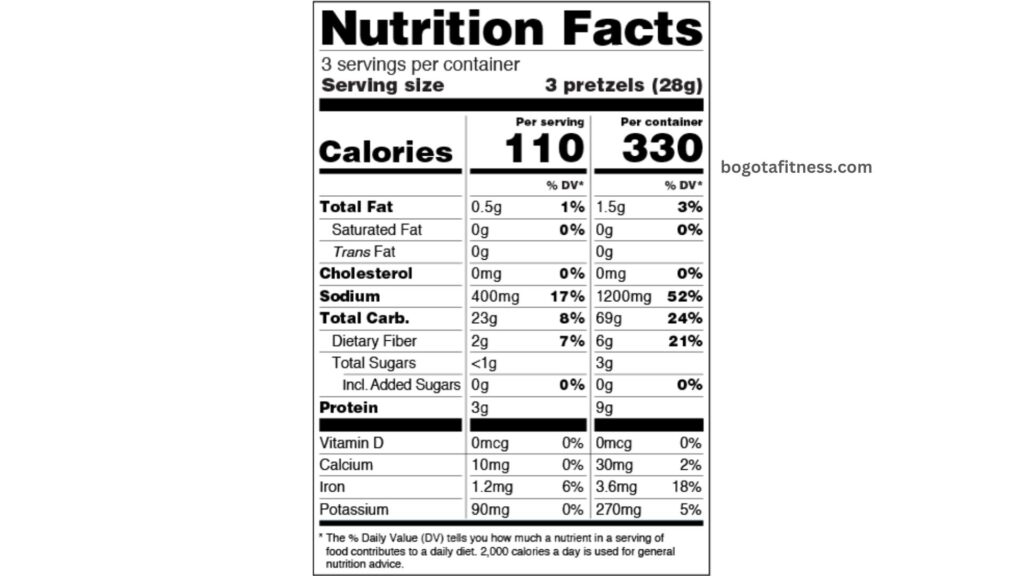
Single-Ingredient Sugar labels
Products like pure honey, pure maple syrup, or pure sugar packaging and containers are exempt from having to list the grams of added sugar per serving; however, they still need to list the percentage of daily value that is added sugar. Manufacturers are urged, but not required, to use the “…” symbol right after the Added Sugars percent Daily Value on single-ingredient sugars. This will result in a footnote that explains how much added sugar a serving of the product adds to the diet and how much a serving contributes to the Added Sugars percent Daily Value. The purpose of this labeling strategy for single-ingredient sugars and syrups is to assure customers of the amount of added sugars in a serving and how it fits into their overall diet, without giving the impression that extra sugars have been added to the product.
This is an illustration of what a label for a sugar made from just one component, like honey, may look like.
Honey
